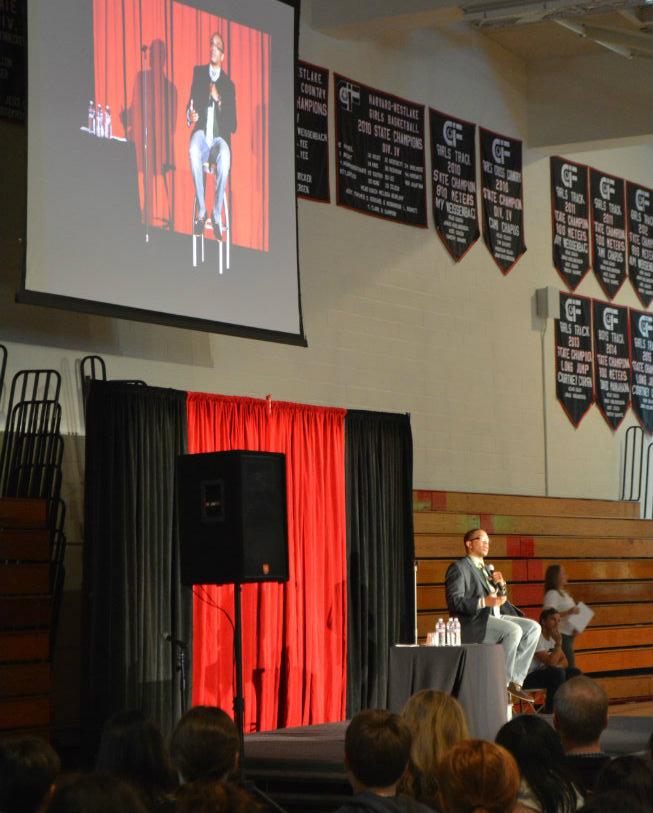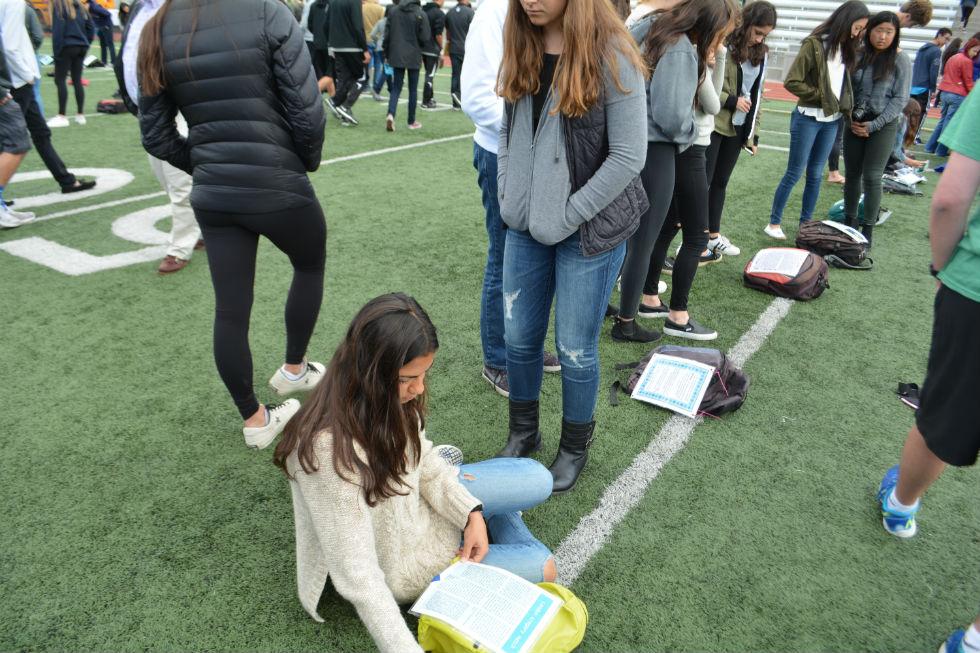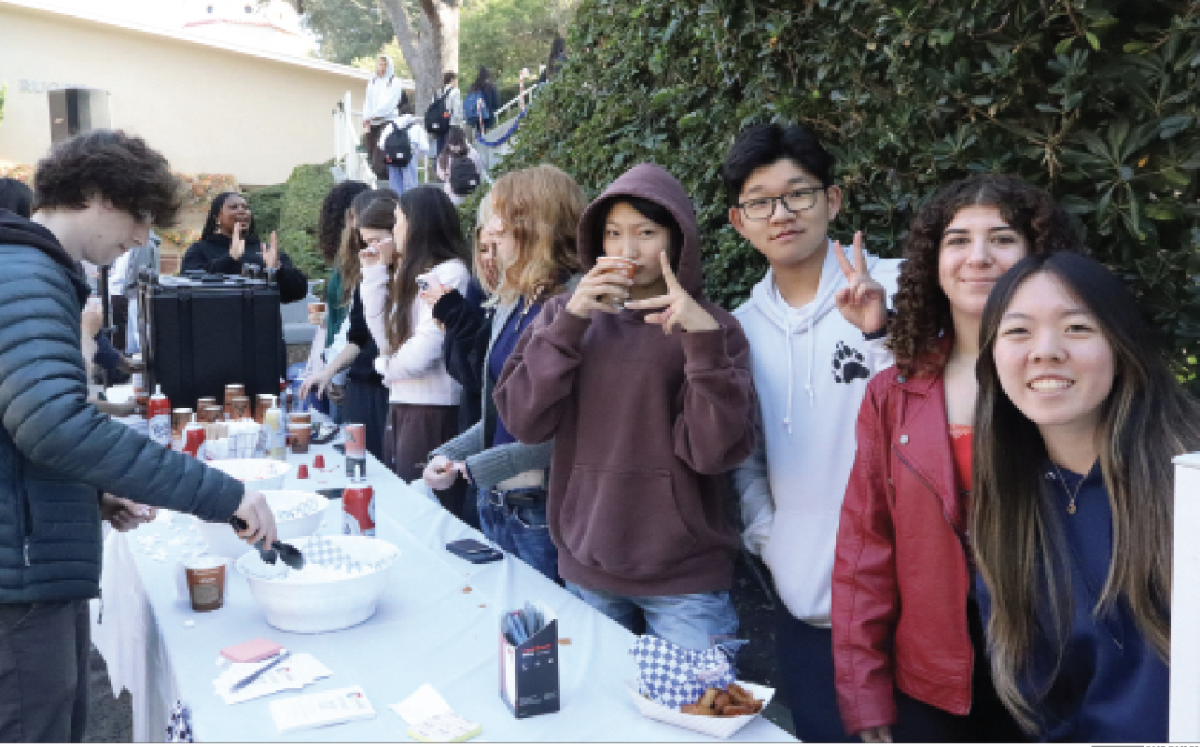Mental health advocate Jordan Burnham urged students to feel comfortable seeking treatment for mental health issues and to talk about them to get help. He shared his story of attempted suicide Wednesday during an assembly designed to help reduce the stigma surrounding such issues and disorders.
The presentation also included a display by the Active Minds nonprofit of 1,100 empty backpacks on the field to represent the number of college students who commit suicide every year.
“Twenty to 25 percent of young adults will suffer from a mental health disorder in any given year, but a lot of them won’t seek help or seek treatment, because in our society it’s okay if you struggle with your stress, maybe if you have anxiety, but you’re looked down upon if you talk about these issues, go to seek treatment or go to seek help,” Burnham said. “But I’m hoping that by the end of this presentation it makes it easier for anyone in here to have that conversation if they need to.”
At the beginning of his senior year in high school, Burnham, who had been struggling with depression for years, jumped out of his nine-story bedroom window after his parents found alcohol in the trunk of his car.
“[I thought] What’s the point of being on this Earth if I can’t make my mom, my dad, my sister, if I can’t make them happy, what’s the point of being here?” Burnham said.

He first started struggling with depression during his freshman year of high school. He had changed schools for the second time, but this time he did not have his sister, who was in college, to lean on, and did not want to talk to the school’s therapist.
“This was the first time I kept any depressed, lonely thoughts to myself,” he said. “I thought you only talked to a therapist in an extreme situation like someone close to you passing away or your parents getting divorced. I didn’t know I could walk into her office and just say, ‘Hey, I’m having a bad day. Could we please talk about it?’ So I shied away from her office.”
While he had started to fit in and was elected ninth grade class president, he continued to struggle.
“It was something I should’ve been happy and proud of, but at the same time I felt like I was in a community, but I wasn’t really a part of it,” Burnham said. “I was going to school with a mask on my face, hiding the fact that I felt depressed, I felt lonely, and I felt that I didn’t belong. Going to school with fake laughs and fake smiles.”
He saw a therapist for the first time during his sophomore year and was diagnosed with depression, but said that he did not consistently take his medication, tried to get out of therapy sessions as quickly as possible and began to use alcohol as a coping mechanism.
Burnham’s parents had caught him drinking during his junior year, and that summer he put his father’s job at the high school in jeopardy after the police had to break up a party he threw while his parents were out of town. A few months later, his father confronted him about the alcohol he had found in Burnham’s car.
“By the time senior year started I was constantly having suicidal thoughts,” he said. “This was impulsive. I didn’t plan it, didn’t write a letter or a note. Sept. 28, 2007 started out just like any other Friday of high school. But, for some reason my dad dropping a duffel bag was a trigger in my brain saying, ‘I don’t belong here anymore.'”
Now, Burnham treats his depression with therapy and medication, and travels with the nonprofit mental health advocacy group Active Minds sharing his story to diminish the stigma surrounding mental health disorders among students. He spoke at the White House and before Congress about mental health, and was featured in the Washington Post, Sports Illustrated and USA Today.
“That’s the entire conversation I hope you guys can continue amongst yourselves, so that when I’m back home you guys are still continuing this conversation not just today, not just tomorrow, but next week, next month, and truly making mental health a relevant subject in your school,” Burnham said.
Students appreciated both Burnham’s message and his experience.
“It was nice to listen to a personal story and not just read statistics,” Kayla Darini ’16 said.
Following the presentation, students had the opportunity to talk to counselors and to walk along the Send Silence Packing display, which was set up by Active Minds.
In the display, students reflected on the empty backpacks which had stories about students who took their own lives.

“I thought both the assembly and the display of backpacks on the field was one of the most moving and powerful assemblies and speakers that we’ve had,” Allison Gorokhovsky ’17 said. “Particularly because it touched me very deeply. I have a lot of friends who suffer from suicide attempts, and to me it was an awakening that there’s still something I can do to be there for them.”
Assistant to the Head of Upper School Michelle Bracken, who helped coordinate the assembly, said that the coordinators first had the idea to address the issue of mental health disorders after the New York Times article, “Campus Suicide and the pressure of Perfection,” had circulated among the administration, counselors and deans.
“This seemed like an opportunity to address an issue that is difficult to talk about, but also an important one,” Bracken said. “HW prepares students for college academically, we should also care about student’s mental health. By making time in our school day dedicated to mental health and suicide, we can bring information that might help our students.”
After the assembly, Chaplain Jay Young sent students an anonymous survey asking for their thoughts and feedback, which was suggested by Active Minds, Young said.
However, some students felt that the survey did not mesh with the theme of the assembly.
“It just didn’t seem appropriate after having the presentation and putting extra emphasis on coming together that we would then anonymously and electronically ‘turn in’ our friends rather than going to see [Counselor Luba] Bek in person,” Genny Thomas ’16 said.
Others felt that the survey was sufficient.
“Personally I don’t think there’s a good way to take a survey on how people emotionally feel and how they’re touched,” Gorokhovsky said. “I thought the survey was as good as it could have gotten.”
According to Young, the organization uses the surveys to make adjustments their presentations.
“We have always urged our students to confide in a trusted adult if they are worried about one of their peers,” Young said. “While this survey may be a new vehicle for doing so, the idea itself is not new at all.”
Bracken also added that she hopes students struggling with a mental health issue or disorder will seek help from a counselor or dean.
“It is OK to struggle, but not OK to struggle alone,” Bracken said.





























